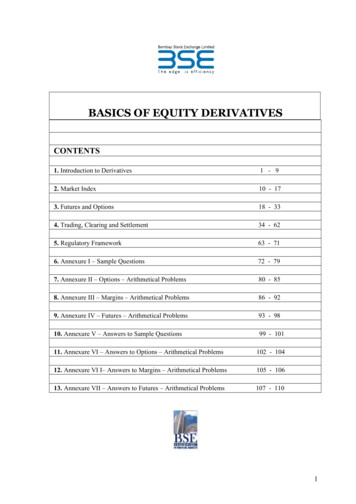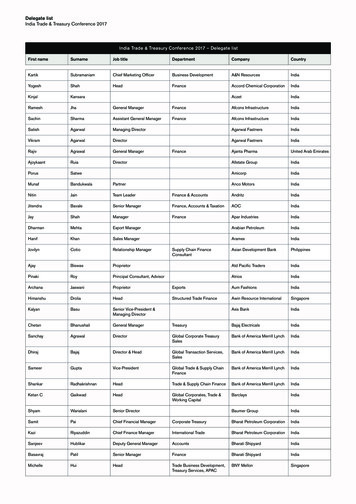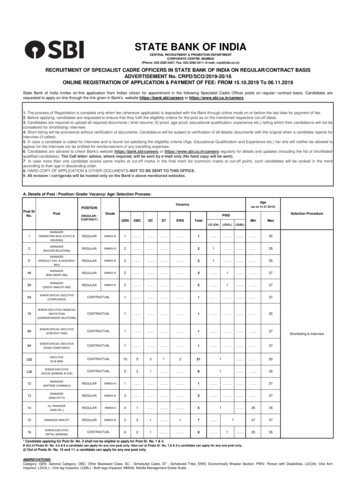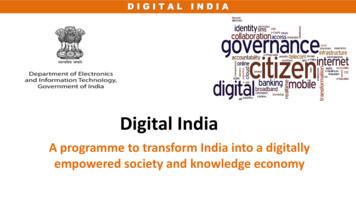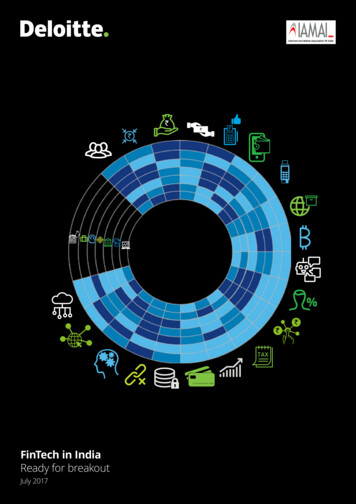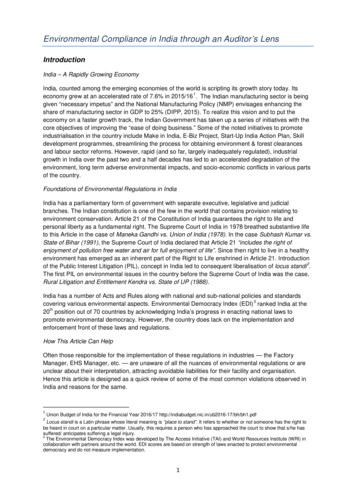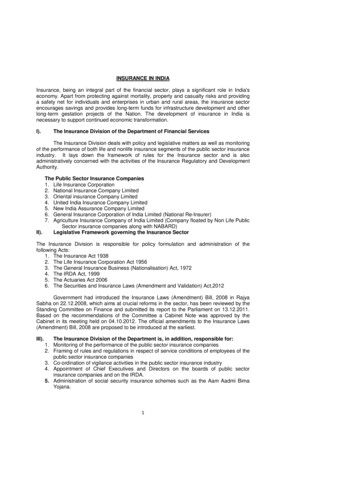
Transcription
INSURANCE IN INDIAInsurance, being an integral part of the financial sector, plays a significant role in India'seconomy. Apart from protecting against mortality, property and casualty risks and providinga safety net for individuals and enterprises in urban and rural areas, the insurance sectorencourages savings and provides long-term funds for infrastructure development and otherlong-term gestation projects of the Nation. The development of insurance in India isnecessary to support continued economic transformation.I).The Insurance Division of the Department of Financial ServicesThe Insurance Division deals with policy and legislative matters as well as monitoringof the performance of both life and nonlife insurance segments of the public sector insuranceindustry. It lays down the framework of rules for the Insurance sector and is alsoadministratively concerned with the activities of the Insurance Regulatory and DevelopmentAuthority.The Public Sector Insurance Companies1. Life Insurance Corporation2. National Insurance Company Limited3. Oriental insurance Company Limited4. United India Insurance Company Limited5. New India Assurance Company Limited6. General Insurance Corporation of India Limited (National Re-Insurer)7. Agriculture Insurance Company of India Limited (Company floated by Non Life PublicSector insurance companies along with NABARD)II).Legislative Framework governing the Insurance SectorThe Insurance Division is responsible for policy formulation and administration of thefollowing Acts:1. The Insurance Act 19382. The Life Insurance Corporation Act 19563. The General Insurance Business (Nationalisation) Act, 19724. The IRDA Act, 19995. The Actuaries Act 20066. The Securities and Insurance Laws (Amendment and Validation) Act,2012Government had introduced the Insurance Laws (Amendment) Bill, 2008 in RajyaSabha on 22.12.2008, which aims at crucial reforms in the sector, has been reviewed by theStanding Committee on Finance and submitted its report to the Parliament on 13.12.2011.Based on the recommendations of the Committee a Cabinet Note was approved by theCabinet in its meeting held on 04.10.2012. The official amendments to the Insurance Laws(Amendment) Bill, 2008 are proposed to be introduced at the earliest.III).The Insurance Division of the Department is, in addition, responsible for:1. Monitoring of the performance of the public sector insurance companies2. Framing of rules and regulations in respect of service conditions of employees of thepublic sector insurance companies3. Co-ordination of vigilance activities in the public sector insurance industry4. Appointment of Chief Executives and Directors on the boards of public sectorinsurance companies and on the IRDA.5. Administration of social security insurance schemes such as the Aam Aadmi BimaYojana.1
IV).An Overview of the Insurance SectorThe insurance sector was opened for private participation with the enactment of theInsurance Regulatory and Development Authority Act, 1999. Since opening up of the sector,the number of participants in the industry has gone up from six insurers (including LifeInsurance Corporation of India, four public sector general insurers and General InsuranceCorporation as the National Re-insurer) in the year 2000 to 52 insurers as on 31st March,2013 are operating in the life, non-life and re-insurance segments (including specializedinsurers, viz. Export Credit Guarantee Corporation and Agriculture Insurance Company ofIndia Limited (AICIL). Four of the general insurance companies‟ viz. Star Health andAlliance Insurance Company, Apollo Munich Health Insurance Company, Max BUPA HealthInsurance Company and Religare Health Insurance Company function as standalone healthinsurance companies. Of the twenty three life insurance companies which have set upoperations in the life segment post opening up of the sector, twenty one are in joint venturewith foreign partners. Of the twenty one companies which have commenced operations inthe non-life segment, eighteen had been set up in collaboration with foreign partners. Thus,thirty nine insurance companies in the private sector are operating in the country incollaboration with established foreign insurance companies from across the globe as on 31stMarch, 2013.No. of Insurance CompaniesTotal number of insurersLife InsurersGeneral insurersSpecialized InstitutionsStand-alone Health InsurersReinsurerV).2000PublicSector141As on 31.03.2013Private Public Total No. ofSector Sector Insurers (Public & Private)2312417421224411Industry Performance Outlook Insurance penetration or premium volume as a ratio of GDP, for the year2012-13 stood at 3.96% for the insurance sector. The insurance penetrationof the general insurance sector stood at 0.78% in 2012-13. Penetration of thelife insurance sector stood at 3.17% during the same year, having declinedfrom a peak of 4.60% in 2009. Insurance penetration in some of the emergingeconomies of Asia i.e. Malaysia, Thailand and China, in 2012 was 4.8%, 5%and 3% respectively. Insurance density measured as the ratio of premium to population (percapita premium) for 2012-13 stood at US 53.2 for the insurance sector as awhole. The density in respect of the general insurance sector has beenincreasing consistently reaching a peak of US 10.5 in 2012.Density inrespect of the life insurance sector stood at 42.7 in 2012, having declinedfrom the peak of 55.7 in 2010. The figures of insurance density forMalaysia, Thailand and China during 2012 were US 514.2, US 266.2 andUS 178.9 respectively. The total premium underwritten in India by the general insurancecompanies for the year 2012-13 is Rs. 62,973 crore registering a growth of2
19.10 % over 2011-12. The public sector general insurers exhibited a growthof 14.60% while private sector general insurers registered a growth of 25.25%in 2012-13. There was a marginal increase in the total premium underwritten in the lifeinsurance sector from Rs. 2,87,072 crore in 2011-12 to Rs. 2,87,202 crore in2012-2013. While private sector life insurers posted a decline of 6.87% intheir premium income during 2012-13, LIC recorded 2.92% growth ascompared to the previous year. In 2012-13, the market share of public sector general insurance companiesstood at 55.61% with a total premium of Rs. 35,022 crore. The private sectorgeneral insurance companies wrote a premium of Rs 27,951 crore amountingto 44.39% of the total general insurance premium. With respect to lifeinsurance sector, the market share of LIC in terms of total premium,increased from 70.68% in 2011-12 to 72.70% in 2012-13. The private sectorlife insurance companies held a share of 27.30% in 2012-13, as against29.32% in 2011-12. There were 8,099 offices of general insurance companies spread all overIndia as on 31st March 2013 of which 6272 belonged to the public sectorwhereas there were 10,285 offices of life insurance companies spread allover India as on 31st March 2013 of which 3,526 belonged to LIC. Pursuant to the announcement made by the Finance Minister in the BudgetSpeech 2013-14, and in order to reach the masses, the public sectorinsurance companies are opening offices in all unrepresented towns havingpopulation of 10,000 or more (up to Tier IV towns as per census 2001classification). The public sector general insurance companies have alreadyopened 1849 offices and LIC has opened 1252 offices in the unrepresentedtowns. An additional 10 such offices will be opened by the four public sectorgeneral insurance companies and 19 such offices would be opened by LIC bythe end of February 2014. The general insurers issued 1,070.24 lakh policies in 2012-13 as against857.44 lakh policies in 2011-12, reporting a growth of 24.82%. The publicsector general insurers witnessed considerable growth of 30.59% in thenumber of policies issued during 2012-13, while the private sector generalinsurers reported a growth of 15.57%. The New Policies issued by the Life Insurance Sector in 2012-13, were of theorder of 441.87 lakh out of which 367.82 lakh policies were issued by LIC(83.24% of total policies issued) . While LIC registered a growth of 2.88% inthe number of new policies issued against the previous year, the privatesector life insurers reported a decline of 12.88%. Overall, during 2012-13, theindustry witnessed a 0.01% decline in number of new policies issued. In order to extend insurance coverage in rural and social sectors, IRDA hasalso issued Regulations which specify the obligations of the insurers in ruraland social sectors. Targets are laid down depending on the age of the insurerin terms of its incorporation. The general insurers covered 2,030.87 lakh livesin the social sector during 2012-13 of which the public sector companiesaccounted for 1,670.04 lakh lives. The public and private general insurersunderwrote 12.87% and 12.47% of their gross direct premium respectively inthe rural sector during 2012-13.3
VI).VII). LIC wrote a higher percentage of policies in the rural sector than theprescribed 25% for the year 2012-13 and similarly for the social sector itexceeded the prescribed coverage of 20 lakh lives for 2012-13. The total investments held by the insurance sector as on 31.3.2013, were Rs.18,67,886 crore. Life insurers contributed a major share of Rs. 17,44,894crore (93.42%) of the total investments held by the industry. The share ofnon-life insurers was Rs. 1,22,992 crore (6.58%). The public sector insurancecompanies contributed 80% in the total investments of the industry.Investment in housing and infrastructure as on 31.3.2013 was 7.93% of thetotal investments.Life insurance industry From being the sole provider for life insurance till the financial year 19992000, LIC is today competing in the industry with private sector insurers whichhave commenced operations over the period 2000-2012. The life insuranceindustry (first year premium) has shown an annualized growth of 37%between 1996-97 and 2000-2001 and 27.04% between 2001-02 and 201213. This growth has been achieved on the increased base of premiumunderwritten. The first year premium, which is a measure of new business secured,underwritten by the life insurers during 2012-13 was Rs.1, 07,011 crore ascompared to Rs.9, 707 crore in 2000-01. The life insurance industryunderwrote 441.86 lakh policies in 2012-13 reporting a decline of 0.01 percent (previous year 441.92 lakh policies). There was a marginal increase inthe total premium underwritten in the life insurance sector from Rs. 2,87,072crore in 2012 to Rs. 2,87,202 crore in 2012-2013. The share of ULIP business in the first year premium in 2012-13 was 10.11per cent while that of non-linked premium was 89.89 %. A notable feature of the opening of the life insurance market has been thatthe size of the life insurance pie itself is expanding. Insurance penetrationwhich was 1.41% of GDP in 1995 has grown to 3.17% of GDP in 2012.However, there has been a decline during 2012 as compared to 3.40% in2011. Insurance density is US 42.70 (Premium per capita in USD) in 2012which was US 49.00 in 2011.Non-life insurance industry:The non-life insurers (excluding specialized institutions like ECGC and AICLand the standalone health insurance companies) underwrote premium withinIndia of Rs. 62,973 crore in 2012-13, as against Rs.9, 806.95 crore in 2000-01,The total premium underwritten in India by the general insurance companiesfor the year 2012-13 is Rs. 62,973 crore as against 52876 crores in 2011-12thereby registering a growth of 19.10 % over 2011-12. Two of the fastestgrowing segments are Motor and Health accounting for 46.49 and 24.36 percent of the premium underwritten in India in 2012-13. The premiumunderwritten in these two segments in 2012-13 was Rs. 29,777 crore and Rs.15,341 crore respectively, reporting growth of 22.85 and 17.18 per cent over2011-12. The number of policies underwritten in 2012-13 was 9,91,89,578 asagainst 8,57,43,820 in 2011-12. The penetration of the Non-Life Insurancesector in the country has remained in the range of 0.55 - 0.78% over the last4
13 years (0.70% in 2011 and 0.78% in 2012). The insurance density of NonLife insurance sector reached the peak of US 10.50 in 2012 from its level ofUS 2.4 in 2001.VIII).FDI in Insurance SectorAt present, the foreign equity up to 26% is allowed in insurance sector. TheFDI has been put in the automatic route. The Finance Minister in the BudgetSpeech of financial year (2004-05) has announced hiking of Foreign DirectInvestment (FDI) limit in Indian insurance companies. Accordingly,Government has introduced the Insurance Laws (Amendment) Bill, 2008 in theRajya Sabha on 22.12.2008. The Bill inter-alia, provides for enhancement ofholdings of equity shares by the foreign company, either by itself or through itssubsidiary companies or its nominees in Indian Insurance Companies fromtwenty six per cent to forty nine per cent except in case of insurance cooperative societies where the limit continues to be 26% as at present. The Billis yet to be passed.IX).Social Security Scheme- Aam Aadmi Bima Yojana (AABY) Government has merged the two social sector life insurance Schemes viz.Janashree Bima Yojana (JBY) and the Aam Aadmi Bima Yojana (AABY) intothe Aam Aadmi Bima Yojana (AABY). The merger would enable betteradministration and services in providing life insurance cover to theeconomically backward sections of society. The Scheme extends life and disability cover to persons between the age of18 years to 59 years, living below and marginally above the poverty line under47 identified vocational/occupational groups, including „rural landlesshouseholds‟. The member should be the head of the family or one earningmember of the family under the eligible groups. The Scheme provides for insurance cover for a sum of Rs. 30,000/- onnatural death, Rs.75,000/- on death due to accident, Rs.37,500/- for partialpermanent disability (loss of one eye or one limb) due to accident and Rs.75,000/- on death or total permanent disability (loss of two eyes or two limbsor loss of one eye and one limb) due to accident. The Scheme also providesan add-on benefit, wherein Scholarship of Rs100 per month per child is paidon a half-yearly basis to a maximum of two children per member, studying in9th to 12th Standard (including ITI courses). The total annual premium under the Scheme is Rs.200/- per beneficiary, 50per cent of which is contributed from the Social Security Fund created by theCentral Government and maintained by LIC. The balance 50 per cent of thepremium is contributed by the State Government/UTs in the case of „RuralLandless Households‟ and for the other groups, it is contributed by the StateGovernment / Nodal agency/ Individual. The Central Ministerial Dept. ionalizedarrangement/registered NGOs may act as nodal agencies under the Scheme.However, in case of „Rural Landless Households‟ category, it is the StateGovernment/ UT which will be the Nodal Agency. The Scheme is being implemented through Life Insurance Corporation ofIndia (LIC) in the country.5
X).XI.Recent initiatives by the Insurance Companies Business Process Re-Engineering & Core Insurance Solutions:TheBusiness Process Re-engineering (BPR) and implementation of CoreInsurance Solutions has been undertaken through usage of IT in order toenhance their efficiency by rendering services in a more professional mannerat a quicker pace. E-governance plans have been formulated and beingimplemented to ensure focus on customer in all fields of operations; Customer Centric Innovations: Customer awareness through Informationabout products and other related information on the web Portals of GIPSACompanies. Online issuance of policies including premium calculations,online receipt of premium, online issuance of select policies are available onthe web Portals of the PSGICs. Online intimation & tracking of claims is alsoavailable. Online registration of grievances and tracking of grievance status isalso available on the website of the PSGICs. Preferred Provider Network (PPN): Creation of a common Preferred ProviderNetwork (PPN) for all the 4 GIPSA Member Companies which involvesempanelment of hospitals after due negotiations on rationalization of chargesfor prescribed procedures for similarly placed service providers in the interestof policy holders. Common Third Party Administrator (TPA) Initiative: Initiative for a CommonThird Party Administrator which can be a game changer by way of setting thebenchmarks for services and standardization of practices in the HealthSector. This may create an environment of competition that encouragesemulation thereof by the other existing Third Party Administrators leading togreater benefit to the beneficiaries under the insurance policies. This initiativewould also enable leveraging of volumes by the insurance companies in thebest interest of all the stakeholders creating a positive image of Public SectorGeneral Insurance Companies amongst the insuring public. Common Mechanism for Compromised Settlement of Third Party ClaimsCMCSTPC: Framing and implementing the Scheme of Common Mechanismfor Settlement of Compromised Third Party Cases (CMCSTPC) whichinvolves setting up of independent Committees of experts from the Judicial,Medical and Insurance fields who can adjudicate on the pending Motor ThirdParty Claims without the insured having to go through the tedious and timeconsuming legal processes. Four Pilot Projects were launched at Cuttack,Kochi, Ahmadabad & Jaipur Centres and thereafter new Centres are beingopened at different towns which have substantial pendency of cases.Major Initiatives by the Government First decade – Growth: The experience over the decade since the opening upof the sector has provided a good learning ground. The key reforms, startingwith privatisation of the sector in 2000 followed by de-tariffication of the nonlife sector in 2007, have helped the sector grow with insurance reaching outto the masses. Initiatives such as standardization of “pre-existing diseases”clause and allowing portability of health insurance, promoting microinsurance,formulating anti-money laundering policy for the industry,providing for data warehousing, focusing on improving corporate governance,e-governance and ensuring transparency through disclosures in financialstatements and ensuring customer satisfaction through Grievance RedressalMechanism by commissioning of the Integrated Grievance Management6
System (IGMS) by the Regulator have contributed to the development of thesector. Second Decade – Consolidation: At the beginning of the second decadesince opening up of the sector, both the Government and the Regulator areengaged in addressing the challenges arising due to consolidation of thesector. While the Regulator will look into its part of the role in the process, theGovernment has initiated the process of further reforms in the InsuranceSector. As a result, a few legislative amendments have been brought aboutwhile others are in the process of consideration. The LIC (Amendment) Bill,2011 has been passed by the Parliament enabling LIC to raise its equitycapital from Rs. 5 crore to Rs. 100 crore and create a reserve fund to beutilized for its business expansion and meeting its corporate socialresponsibility. The Insurance Laws (Amendment) Bill is aimed at bringingabout crucial sectoral reforms such as increasing the FDI limit from 26% to49%. The Bill, which is under review and consideration, seeks to (i) permitforeign re-insurers to open branches to transact re-insurance business inIndia (ii) allow the entry of Lloyds of London syndicates to transact insurancebusiness in India and (iii) remove the restriction on divestment by Indianpromoters of insurance companies. All the proposed changes are aimed atdeepening the insurance sector through better penetration, both vertically andhorizontally, importing latest technology for business process reengineeringand a cost effective delivery system. The G
Insurance penetration or premium volume as a ratio of GDP, for the year 2012-13 stood at 3.96% for the insurance sector. The insurance penetration of the general insurance sector stood at 0.78% in 2012-13. Penetration of the life insurance sector stood at 3.17% during the

